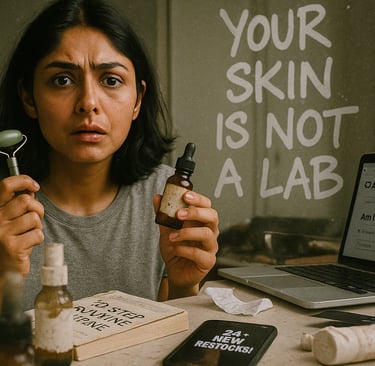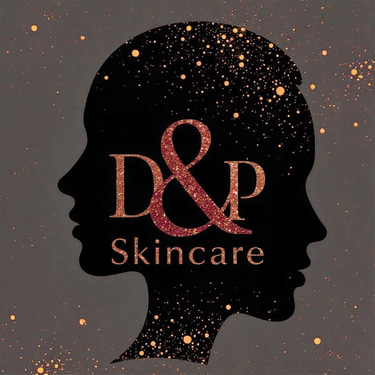Your Skin Is Not a Lab
Tired of a 15-step routine? Discover a simple skincare routine that actually works. Learn the secrets of effective skincare for Indian skin and why less is more for a natural, healthy glow.


Chapter 1: The 15-Product Morning That Changed Everything
It was 6:30 AM on a Tuesday when I found myself standing in front of my bathroom mirror, holding my seventh skincare product of the morning.
Cleanser ✓
Toner ✓
Essence ✓
Vitamin C serum ✓
Niacinamide ✓
Hyaluronic acid ✓
And I was only halfway through my "morning glow routine."
My vanity looked like a skincare store had exploded. Bottles and tubes everywhere, each promising to be the missing piece of my "glass skin" puzzle. I had acids for brightening, serums for plumping, essences for hydrating, and treatments for problems I wasn't even sure I had.
That's when it hit me: When did taking care of my skin become a part-time job?
More importantly, after spending ₹50,000 on products in the past six months, why did my skin look worse than when I started?
Chapter 2: The Instagram Trap
It all began innocently enough. Like millions of others, I fell down the skincare rabbit hole during the pandemic. Stuck at home, scrolling through Instagram, I was bombarded with before-and-after photos that seemed too good to be true.
"Get glass skin in 30 days!"
"This Korean routine changed my life!"
"5 products that will transform your skin!"
The influencers made it look so simple. Their skin glowed like they had inner lighting, and they spoke about ingredients like niacinamide and retinol with the confidence of dermatologists.
I wanted what they had. I wanted that confidence, that glow, that seemingly effortless beauty.
So I started buying. First, it was the viral Vitamin C serum everyone was raving about. Then the "holy grail" cleanser. Then the essence that promised to give me "that Korean glow."
Each package that arrived felt like Christmas morning. This would be the one. This would finally fix my skin.
Chapter 3: The Ingredient Obsession
Soon, I wasn't just buying products – I was collecting ingredients like Pokemon cards.
Got niacinamide? Check.
Added hyaluronic acid? Check.
Retinol for anti-aging? Check.
AHA for exfoliation? Check.
BHA for deep cleaning? Check.
I memorized ingredient lists, joined Reddit communities, and could pronounce "bakuchiol" without stumbling. I felt smart, informed, like I had cracked some secret code.
But my skin told a different story.
The breakouts got worse. What I thought was "purging" never stopped. My skin became sensitive to products I'd used for months. Dark spots that were supposed to fade seemed to multiply.
The more products I added, the more problems appeared. It was like my face was fighting a war, and I was accidentally supplying weapons to both sides.
Chapter 4: The Moment of Truth
The breaking point came during a video call with my mom.
"Beta, what happened to your skin?" she asked, genuine concern in her voice. "You used to have such nice, clear skin in college."
She was right. In college, my routine was simple: a basic face wash, some moisturizer, and sunscreen when I remembered. My skin wasn't perfect, but it was healthy. It was mine.
Now it looked like I was conducting science experiments on my face every morning and night.
That evening, I did something I hadn't done in months – I looked at old photos. There I was, laughing with friends, my skin looking naturally radiant without fifteen products layered on top.
What had changed? When did I stop trusting my skin and start treating it like a problem that needed solving?
Chapter 5: The Research Rabbit Hole
Determined to understand what went wrong, I started digging deeper – not into beauty blogs or influencer posts, but into actual research about skin physiology, particularly for Indian skin.
The discoveries were eye-opening:
Discovery #1: The Climate Factor
Those Korean routines I was obsessing over? They were designed for Seoul's climate – cool, less humid, with different UV patterns. Mumbai's humidity, pollution, and intense sun created completely different skin needs.
Discovery #2: The Melanin Difference
Indian skin, rich in melanin, responds differently to active ingredients. What works for pale skin can cause hyperpigmentation for us. Those before-and-after photos I was chasing? Most weren't even from people with similar skin tones.
Discovery #3: The Marketing Lie
"Suitable for all skin types" was the biggest myth of all. No product could possibly work for the dry skin of someone in Rajasthan's desert AND the oily skin of someone in Kerala's humidity.
Chapter 6: The Influence of Influencers
I started looking more critically at the influencers I'd been following religiously.
Sarah, with her perfect skin, casually mentioned getting monthly facials. (She didn't mention this in her "budget skincare routine" video.)
Priya talked about her "all-natural glow" while tagged location showed she was at an aesthetic clinic.
James shared his "simple routine" but his story showed him using products worth more than most people's monthly salary.
The reality hit hard: These people weren't succeeding because of the products they promoted – they were succeeding despite them.
Most had:
Professional treatments they didn't disclose
Genetic advantages they took for granted
Lifestyles that supported good skin (professional makeup artists, nutritionists, stress-free environments)
Financial resources for damage control when experiments went wrong
I was taking advice from people whose skin problems were solved by privileges I didn't have.
Chapter 7: The Root Cause Revolution
Frustrated and broke, I decided to approach this differently. Instead of asking "What products should I use?" I started asking "Why do I have these problems?"
My acne wasn't just about clogged pores – it was worse during exam stress and better during holidays.
My dark spots weren't just about sun damage – they appeared after every pimple, and got darker when I picked at my skin.
My dullness wasn't just about lack of exfoliation – it was worse when I wasn't sleeping well or eating properly.
The problems weren't on my skin – they were coming from inside my life.
No amount of topical products could fix problems that were rooted in stress, diet, sleep, and lifestyle factors.
Chapter 8: The Simplification Experiment
I decided to try something radical: I stopped everything.
For one week, I used only three things:
A gentle cleanser
A basic moisturizer
Sunscreen
My skin panicked for the first few days. It was like detoxing from an addiction. But by day four, something interesting happened – the constant irritation started to calm down.
By week two, my skin looked... peaceful.
Not perfect. Not Instagram-ready. But healthy. Like it could finally breathe again.
Chapter 9: The Real Truth About Indian Skin
Through this journey, I learned truths that no beauty brand wanted me to know:
Truth #1: Indian skin has been dealing with monsoons, heat, and pollution for generations. It's incredibly resilient – it doesn't need to be "fixed."
Truth #2: Our grandmothers had beautiful skin using turmeric, neem, and coconut oil. These weren't "primitive" solutions – they were intelligent ones.
Truth #3: The skin problems we're told are "normal" – constant breakouts, sensitivity, irritation – are often caused by using too many products, not too few.
Truth #4: Marketing has convinced us that our natural skin state is a problem. But skin that produces oil is protecting itself. Skin that tans is defending itself. Skin that heals with darker marks is doing exactly what melanin-rich skin is supposed to do.
Chapter 10: Building a Routine That Actually Works
Today, my skincare routine takes five minutes, not fifty.
Morning:
Gentle cleanser
Moisturizer with SPF
Evening:
Oil cleanser (if I wore makeup)
Water-based cleanser
One treatment product (I rotate between vitamin C, retinol, or an exfoliant – never layering)
Moisturizer
That's it.
The results? My skin is clearer, calmer, and more radiant than it ever was during my 15-product phase. More importantly, I'm not stressed about my routine, not obsessing over every spot, not feeling like my face is a failed science experiment.
Chapter 11: The Questions That Changed Everything
Before buying any product now, I ask myself:
"Am I buying this because I need it, or because someone convinced me I should want it?"
"Is this solving a real problem I have, or a problem I was told I should have?"
"Do I understand how this works, or am I just hoping it's magic?"
"Is this designed for skin like mine, in a climate like mine, with concerns like mine?"
Most of the time, the answer stops me from adding to cart.
Epilogue: Your Skin Is Not a Lab
Your skin is not a laboratory for beauty companies to test their latest marketing theories.
It's not a canvas for recreating someone else's routine.
It's not a problem that needs solving with an ever-growing collection of products.
Your skin is uniquely, beautifully yours. It has its own wisdom, its own rhythm, its own needs.
The beauty industry profits from making you believe your skin is broken. But what if it's not? What if it just needs you to stop experimenting on it and start listening to it?
What if the best skincare routine isn't about adding more products, but about understanding the skin you already have?
Your skin has been taking care of you your whole life. Maybe it's time to return the favor – not with a chemistry set, but with kindness, consistency, and products that actually understand what Indian skin needs.
Because the most beautiful skin isn't the result of the most expensive experiment – it's the result of the most respectful relationship.
Ready to stop treating your skin like a lab and start treating it like the intelligent organ it is? Discover our curated collection of products designed specifically for Indian skin – because your face deserves better than marketing gimmicks.
